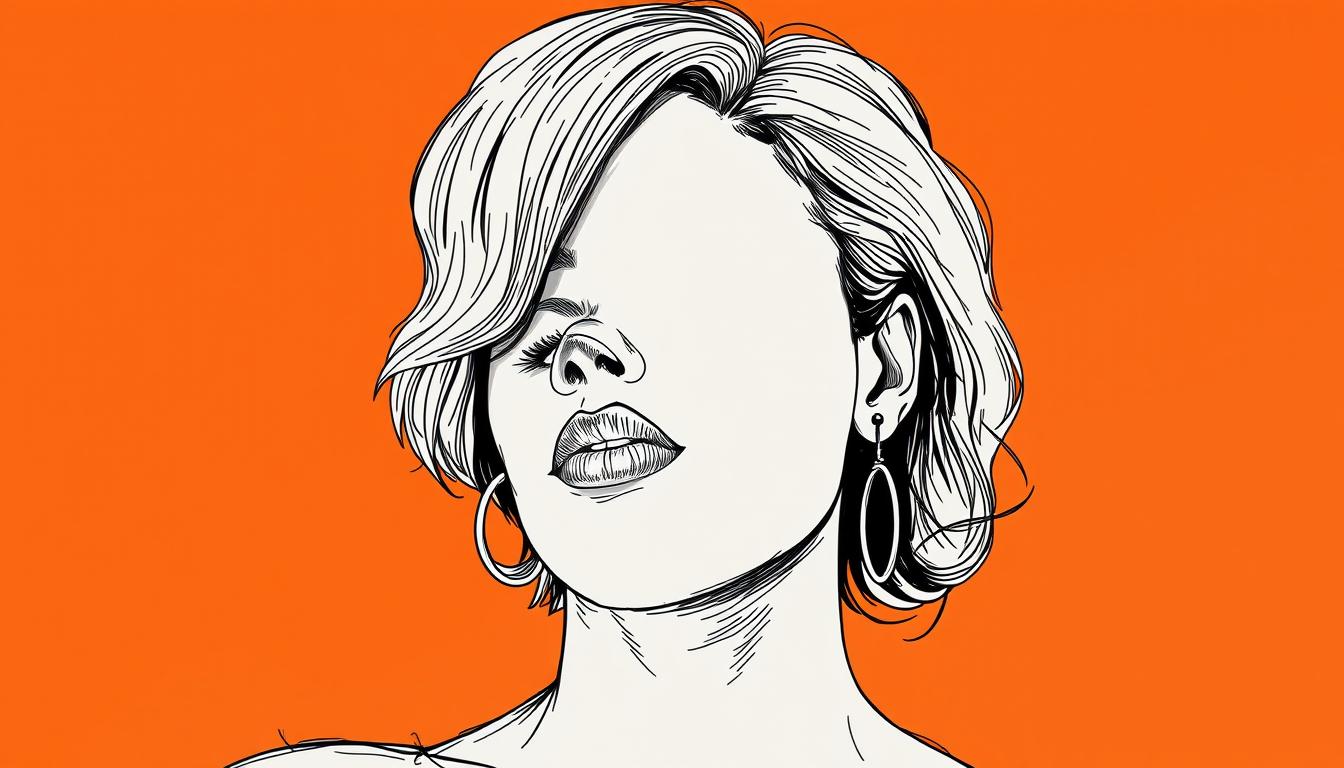Some stars shine through sheer force of talent and resilience. Their light is not a sudden flash but a steady burn built on craft and character. This is the story of an actress who reshaped Hollywood’s landscape for women of color.
Born Maria Halle Berry in Cleveland, Ohio, her journey began on August 14, 1966. She legally changed her name to Halle Maria Berry at five years old. Her path would lead from beauty contests to an historic Academy Award.
She became the first African-American woman to win the Oscar for Best Actress. Her powerful performance in “Monster’s Ball” (2001) cemented her status. This biography traces that remarkable climb.
We explore the roles and choices that defined a legacy. From a Revlon spokesmodel to launching her own production company, 606 Films. Her story is one of determination, authenticity, and barrier-breaking excellence.
Early Life and Family Background
The foundation of her remarkable journey was laid in a Cleveland household defined by maternal strength and paternal absence. These formative years shaped the resilience that would later define her career.
Childhood in Cleveland, Ohio
Born Maria Halle Berry in 1966, her name came from a local department store landmark. At age five, she legally became Halle Maria Berry, the name that would become famous worldwide.
She grew up in Oakwood, Ohio, attending Bedford High School. There she excelled as a cheerleader, honor student, and prom queen. Despite being bullied as a child, she learned to fight back.
Influences and Family Dynamics
Her mother Judith worked as a psychiatric nurse, raising two daughters alone after divorce. The young child witnessed domestic violence that left deep impressions.
She saw her mother endure daily abuse from her father Jerome. This trauma fueled her determination to protect herself and others. The absence of her father created a household led by maternal strength.
These early experiences built the character that would carry Halle Berry through Hollywood’s challenges. Her mixed heritage and difficult childhood became sources of strength rather than limitation.
The Spark: Modeling, Beauty Pageants, and Early Ambitions
The spotlight first found her not on a movie set, but on a pageant stage. These competitions became her unexpected training ground.
Pageant Milestones and Miss USA First Runner-Up
In 1985, she won Miss Teen All American. This marked her first major victory. The following year brought even greater success.
She captured the Miss Ohio USA crown in 1986. This victory propelled her to the national Miss USA competition. There, she earned the position of first runner-up.
| Year | Pageant | Achievement |
|---|---|---|
| 1985 | Miss Teen All American | Winner |
| 1986 | Miss Ohio USA | Winner |
| 1986 | Miss USA | First Runner-Up |
| 1986 | Miss World | 6th Place |
During the Miss USA interview, she expressed her media ambitions. Judges awarded her the highest score. Her articulate responses showed early promise.
That same year, she made history. She became the first African-American woman to represent the United States at Miss World.
Transition from Modeling to Acting
After the pageant circuit, she entered the world of modeling. This work built industry connections and credibility.
The beauty contests provided essential skills. She learned performance, public speaking, and handling scrutiny. These qualities would serve her well in acting.
Modeling became the bridge to her true calling. The pageant stage was merely the beginning of an extraordinary journey.
Breaking into Hollywood – Early Career and Notable Beginnings
New York City’s streets tested her resolve before Hollywood’s cameras ever did. In 1989, the aspiring actress arrived with dreams but soon faced harsh reality. Money ran out, leading to brief stays in a homeless shelter and YMCA.
Debut Roles in Television and Film
Her situation improved by year’s end with a casting breakthrough. She landed the part of model Emily Franklin in the ABC series Living Dolls. This spin-off of Who’s the Boss? marked her television debut.
During taping, a health crisis emerged. The actress lapsed into a coma and received a type 1 diabetes diagnosis. After Living Dolls cancellation, she moved to Los Angeles determined to continue.
Her film debut came in 1991 with a small but powerful role. Spike Lee’s Jungle Fever featured her as Vivian, a crack addict. She immersed herself completely in the character’s desperation.
Breakthrough in Spike Lee’s Jungle Fever and Boomerang
The performer gained attention for her intense method approach. Reports noted she refused to bathe for days before filming Jungle Fever. This commitment to authenticity defined her early work ethic.
1992 brought the true career breakthrough. She starred opposite Eddie Murphy in the romantic comedy Boomerang. As a confident career woman, she proved she could command the screen alongside major stars.
These early years established a pattern of risk-taking and dedication. Each role built toward the success that would soon follow.
Defining Moments and Award-Winning Performances
Two performances would come to define her career, each demanding a level of emotional honesty few actors could sustain. These roles showcased her deepest capabilities while making Hollywood history.
Portrayal of Dorothy Dandridge in Introducing Dorothy Dandridge
The 1999 HBO biopic became a deeply personal project for the actress. She introduced, co-produced, and fought intensely to bring Dorothy Dandridge’s story to screen.
Playing the first African-American woman nominated for the Academy Award for Best Actress resonated deeply. Her performance earned a Primetime Emmy Award and a Golden Globe Award.
This role allowed her to explore the struggles of a pioneering Black actress. The story mirrored her own experiences navigating Hollywood’s challenges.
Monster’s Ball and the Historic Academy Award Win
Two years later came the performance of her career in Monster’s Ball. She played Leticia Musgrove, the troubled wife of an executed murderer.
Her raw, vulnerable work earned the National Board of Review and Screen Actors Guild awards. Then came the historic Academy Award for Best Actress.
She became the only African-American woman to win this Oscar. In her acceptance speech, she honored “every nameless, faceless woman of color” now given opportunity.
The NAACP praised the moment as hope for judging performance based on skill, not skin color. Though controversial scenes sparked debate, she defended their necessity for the drama’s truth.
Iconic Roles in Major Blockbusters and Franchises
The early 2000s saw the actress step firmly into the world of big-budget franchises. These roles expanded her global reach and demonstrated her box office power.
She took on parts that were both celebrated and criticized. Each choice reflected a willingness to take significant risks.
Embodying Storm in the X-Men Series
Halle Berry joined the X-Men universe in 2000 as Storm. The weather-controlling mutant became one of her most recognizable characters.
She reprised the role in multiple sequels over 14 years. This franchise cemented her status as a leading force in major movies.
Controversial Yet Memorable Performances
In 2002, she became a Bond girl in Die Another Day. Her character, Jinx, was voted the fourth toughest girl on screen.
Filming was not without danger. Debris from a smoke grenade flew into her eye, requiring a quick operation.
The 2004 film Catwoman brought harsh reviews. Despite this, the star showed remarkable grace.
She personally accepted the Razzie Award for Worst Actress. Holding her Oscar, she delivered a humble speech about being a good loser.
| Film | Year | Role Significance |
|---|---|---|
| X-Men | 2000 | Introduced her as a key superhero in a major franchise. |
| Die Another Day | 2002 | Iconic Bond girl role, praised for strength and action. |
| Catwoman | 2004 | Headlined a solo superhero film, despite critical panning. |
These films showcased her appeal across different genres. The call from audiences was strong, even when critics were mixed.
Her journey through these blockbusters proved her resilience. She commanded the screen in thrillers and action movies alike.
Evolution as an Actress and a Producer
Creative control became the next frontier after mastering the art of performance. The actress expanded her influence beyond acting roles.
She sought projects where she could shape narratives from conception to screen. This evolution marked a significant shift in her career trajectory.
Transition into Television with Series like Extant
In 2014, she embraced television with the CBS drama series Extant. The actress starred as astronaut Molly Woods while serving as co-executive producer.
Her character returned from space to face family challenges. The role demanded emotional depth and scientific credibility.
USA Today praised her “dignity and gravity” in the part. The series ran for two seasons, earning positive reviews from critics.
Launch of 606 Films and Expanding Creative Boundaries
That same year, she launched production company 606 Films. The name honored California’s Anti-Paparazzi Bill she helped pass.
Partnering with Elaine Goldsmith-Thomas, she built a platform for meaningful stories. The company focused on women’s narratives often overlooked by studios.
Her directorial debut came with Netflix’s Bruised in 2020. She also starred as a disgraced MMA fighter reconnecting with her son.
| Project | Year | Role | Significance |
|---|---|---|---|
| Extant | 2014-2015 | Star/Co-producer | Television series transition |
| 606 Films | 2014 | Founder | Production company launch |
| Things We Lost in the Fire | 2007 | Lead Actress | Critical drama acclaim |
| Bruised | 2020 | Director/Star | Directorial debut |
Earlier works like Things We Lost in the Fire showed her dramatic range. Critics called her performance “brilliant, as good as she’s ever been.”
These years transformed her from actress to multihyphenate creator. She now influences entertainment through acting, production, and direction.
Halle Berry: Legacy, Impact, and Cultural Significance
A legacy is measured not just by awards won, but by doors opened for others who follow. The actress’s career represents a seismic shift in Hollywood’s landscape.
Breaking Barriers for Women and People of Color
Her historic Oscar win in 2002 remains a defining moment. She became the first African-American woman to receive the Best Actress award.
The victory was celebrated as a call for industry change. The NAACP saw it as hope for judging performance based on skill rather than skin color.
By the late 2000s, she commanded $10 million per film. This proved Black women could achieve top-tier earning power in Hollywood.
Influence on Modern Acting and Pop Culture
Her career created a roadmap for navigating Hollywood as a woman of color. She balanced commercial success with artistic risk-taking.
The star’s willingness to take on difficult roles showed authenticity matters. From crack addicts to grieving mothers, she brought truth to the screen.
As a Revlon spokesmodel since 1996, she influenced beauty standards. Her visibility challenged traditional industry exclusivity.
| Year | Achievement | Significance |
|---|---|---|
| 2002 | Academy Award Win | First African-American Best Actress |
| 2007 | Hollywood Walk of Fame Star | Permanent recognition of contributions |
| 2000s | $10 Million Per Film Salary | Proved earning power for women of color |
| 1996-Present | Revlon Spokesmodel | Influenced beauty industry representation |
Her impact extends to actresses like Viola Davis and Lupita Nyong’o. They walk through doors she helped open.
Final Reflections and Future Endeavors
The same strength that defined her barrier-breaking career also shaped her approach to family life and personal relationships. Her journey includes marriages to baseball player David Justice and singer Eric Benét, each relationship contributing to her growth.
Motherhood became a central focus, with her first child coming from her relationship with model Gabriel Aubry. She fiercely protects her children’s privacy, advocating for anti-paparazzi legislation. Her role as a mother informs her creative choices.
Today, Halle Berry continues to expand her influence. Her directorial debut with the Netflix drama Bruised marked a new chapter. Through 606 Films, she develops projects that challenge conventions in drama and thriller genres.
She remains active in films while building her legacy behind the camera. The actress balances creative control with personal fulfillment, proving her impact extends far beyond any single role.




